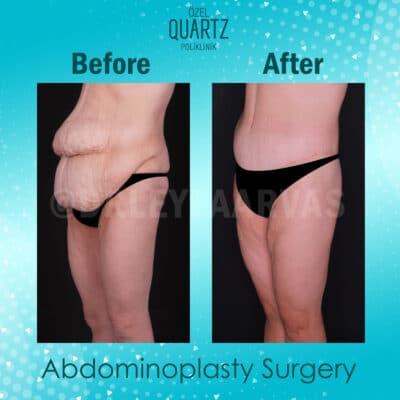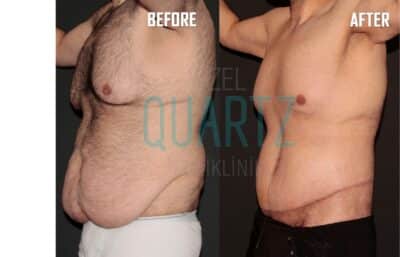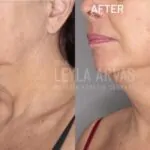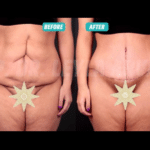Abdominoplasty operation (tummy tuck) is fit for those who frequently lose and gain weight and who want to get rid of the droopy look seen after pregnancy. In abdominoplasty, excess abdomen skin is removed, regional fats are taken out and muscle deformation within the muscle is corrected. With the operation, a flat belly look is created.
This operation creates effective and permanent results in the abdominal area. Tummy tuck can be applied with two different operations depending on the intensity of excess fats in patient’s body and level of drooping, namely mini abdomen tightening or full abdomen tightening.
A full abdomen tightening operation leaves a visible scar hidden underneath your underwear, while a mini abdomen tightening operation leaves a more minimal scar.
 What Is Tummy Tuck Surgery?
What Is Tummy Tuck Surgery?
Tummy tuck surgery, also known as abdominoplasty, is a cosmetic surgical procedure that involves the removal of excess skin and fat from the abdominal area, as well as the tightening of the abdominal muscles. The procedure is typically performed under general anesthesia and takes approximately two to three hours to complete.
Here are the steps involved in a typical tummy tuck surgery procedure:
- Anesthesia: The patient is given general anesthesia to ensure that they are completely asleep and comfortable during the surgery.
- Incision: The surgeon will make a horizontal incision above the pubic area, from hip bone to hip bone. The length of the incision may vary depending on the amount of excess skin and fat that needs to be removed.
- Skin and fat removal: The skin and fat are then separated from the abdominal muscles, and excess skin and fat are removed. The remaining skin and fat are then repositioned to create a smoother, more toned appearance.
- Muscle tightening: The abdominal muscles are tightened by stitching them together. This helps to create a more defined waistline and a flatter abdominal area.
- Incision closure: The skin is then pulled down and sutured into place. The incision is closed using sutures or surgical staples.
- Drains placement: In some cases, small tubes (drains) may be placed under the skin to remove excess fluid and blood during the initial healing process.
- Dressings and compression garment: Dressings are placed over the incision site to protect it, and a compression garment is typically worn to reduce swelling and support the abdomen.
After the surgery, the patient will be monitored closely by medical staff to ensure that there are no complications. Pain medication and antibiotics may be prescribed to manage discomfort and reduce the risk of infection. It is important to follow the post-operative instructions provided by the surgeon to ensure a smooth and successful recovery.
Types of Tummy Tuck Surgeries
There are different types of tummy tuck surgeries, and the appropriate technique depends on the patient’s needs and goals. The most common types of tummy tuck surgeries are:
- Full Tummy Tuck
A full tummy tuck is the most comprehensive procedure that involves an incision from hip bone to hip bone. The plastic surgeon will remove excess skin and fat, repair the abdominal muscles, and reposition the belly button.
Full abdomen tightening operation is recommended to those who have intense cracks, drooping and fats in their belly. With this operation, location of the belly button is also changed due to the effect of abdomen tightening. Abdominoplasty will leave a scar all along close to the person’s groin. This scar gets paler and becomes almost invisible over time.
For a full abdomen tightening, tummy tuck operation, firstly abdominal and fat tissues are pulled from the muscles up to the ribs and excess abdominal skin is cut and removed. Then, excess fat tissue is removed with liposuction, abdominal skin is tightened and sutured. In abdominoplasty, weakness and hernia in abdominal muscles are also treated.
- Mini Tummy Tuck
A mini tummy tuck is a less invasive procedure that involves a smaller incision and focuses on the lower abdominal area. The surgeon will remove excess skin and fat and may tighten the lower abdominal muscles.
Mini abdominoplasty is suitable for those who have intense drooping. Mini abdominoplasty is made with a small incision. Because the belly button is not touched, there will be no prominent change in its location. The belly is tightened and sutured back. Mini abdomen tightening operation takes 1 to 2 hours.
Mini abdominoplasty is generally suitable for those who are at the end of their weight losing process, but cannot obtain the desired tightness in their belly. Mini abdominoplasty does not change the location of the belly button and does not include fat removal. Only drooping and deformed abdominal skin is tightened. IT is recommended to persons having problems with their skin, rather than ones with fats. Mini abdominoplasty is not applied during breastfeeding, either.
- Extended Tummy Tuck
An extended tummy tuck is a more extensive procedure that involves removing excess skin and fat from the abdominal area and the flanks (love handles). In addition to the traditional tummy tuck incision, an additional incision is made along the sides of the abdomen.
Who is a Good Candidate for Tummy Tuck?
To have a full tummy tuck operation, patients must have completed their breastfeeding period. This operation is suitable for those who cannot lose weight despite exercising and diets. Full abdominoplasty is not recommended to overweight people. This operation is not a slimming method. For this reason, you must complete your weight losing process before having this operation.
Tummy tuck surgery, also known as abdominoplasty, is a major surgical procedure that is typically performed on individuals who have excess skin and fat in the abdominal area due to factors such as significant weight loss, pregnancy, or genetics.
Ideal candidates for tummy tuck surgery include:
- Individuals who are in good overall health: Tummy tuck surgery is a major surgical procedure that requires anesthesia and incisions. Candidates should be in good health and free from any underlying medical conditions that could increase the risk of complications.
- Individuals who have excess skin and fat in the abdominal area: Tummy tuck surgery is designed to remove excess skin and fat in the abdominal area. Candidates should have enough excess skin and fat to make the procedure worthwhile.
- Individuals who have a stable weight: Candidates should have a stable weight and be within 10-15 pounds of their ideal body weight. This helps to ensure that the results of the surgery are long-lasting.
- Non-smokers: Smoking can increase the risk of complications and delay healing. Candidates should be non-smokers or willing to quit smoking for several weeks before and after the surgery.
- Individuals with realistic expectations: Candidates should have realistic expectations about the results of the surgery. While tummy tuck surgery can provide dramatic results, it is not a substitute for weight loss or a healthy lifestyle.
It is important to consult with a qualified and experienced surgeon to determine if you are a good candidate for tummy tuck surgery. The surgeon will evaluate your medical history, physical exam, and goals to determine the best course of treatment for your individual needs.
What is Tummy Tuck Benefits?
A tummy tuck, also known as abdominoplasty, can provide several benefits for individuals who have excess skin and fat in the abdominal area. Some of the key benefits of tummy tuck surgery include:
- Improved body contour: Tummy tuck surgery can help improve the overall appearance of the body by removing excess skin and fat in the abdominal area. This can help create a smoother, more toned appearance and a flatter abdomen.
- Increased confidence and self-esteem: Many individuals who undergo tummy tuck surgery report feeling more confident and self-assured after the procedure. This can lead to improved self-esteem and a more positive body image.
- Improved posture: Tummy tuck surgery can also improve posture by tightening the abdominal muscles. This can help reduce lower back pain and improve overall physical functioning.
- Reduction of stretch marks: Tummy tuck surgery can help reduce the appearance of stretch marks on the lower abdomen by removing the affected skin.
- Long-lasting results: The results of tummy tuck surgery are typically long-lasting, as long as the patient maintains a healthy diet and exercise routine. This can help individuals maintain their new body contour and overall appearance for many years to come.
Overall, tummy tuck surgery can be a highly effective way to improve the appearance of the abdominal area and boost overall confidence and self-esteem. However, it is important to understand that it is a major surgical procedure and comes with some risks and potential complications. It is important to consult with a qualified and experienced surgeon to determine if you are a good candidate for the procedure and to discuss the potential risks and benefits.
How Long Does a Tummy Tuck Last?
The results of a tummy tuck surgery, also known as abdominoplasty, can last for many years, as long as the patient maintains a healthy diet and exercise routine. However, it is important to understand that the procedure does not prevent future weight gain or changes in body shape.
The longevity of the results of a tummy tuck will depend on several factors, including the patient’s age, weight fluctuations, and overall lifestyle. While the excess skin and fat that are removed during the surgery will not return, it is still possible for the remaining skin and fat to stretch or sag over time.
To maintain the results of a tummy tuck surgery long-term, patients should follow a healthy diet and exercise routine, and avoid significant weight fluctuations. Regular exercise, including strength training exercises that target the abdominal muscles, can help maintain the tone and firmness of the abdominal area.
It is important to keep in mind that while the results of a tummy tuck surgery can last for many years, they may not be permanent. Patients may require additional surgeries or treatments in the future to maintain or improve their results.
How is Recovery of Tummy Tuck?
Recovery from tummy tuck surgery, also known as abdominoplasty, can take several weeks and requires careful adherence to post-operative instructions to ensure optimal healing and results. Here are some general guidelines for tummy tuck recovery:
- Immediately after surgery: After the surgery, patients will be taken to a recovery area where they will be monitored for a few hours. Once stable, patients are typically discharged home with instructions on wound care, activity restrictions, and medication management.
- Pain management: Pain and discomfort are normal after tummy tuck surgery. Patients will be prescribed pain medication to manage discomfort and will be advised to use ice packs to reduce swelling.
- Wound care: Patients will need to keep the incision site clean and dry to prevent infection. They will also need to change the dressings as instructed by the surgeon.
- Compression garment: A compression garment is typically worn for several weeks after the surgery to reduce swelling and support the abdominal area.
- Activity restrictions: Patients will need to limit their physical activity for several weeks after surgery to allow for proper healing. They will be advised to avoid heavy lifting, strenuous exercise, and any activities that may strain the abdominal muscles.
- Follow-up appointments: Patients will need to attend follow-up appointments with the surgeon to monitor their progress and ensure optimal healing.
- Long-term care: Patients will need to maintain a healthy diet and exercise routine to maintain the results of the surgery long-term.
It is important for patients to carefully follow the post-operative instructions provided by the surgeon to ensure a smooth and successful recovery. Any concerns or complications should be promptly reported to the surgeon to ensure appropriate care.
What is the Recovery Time for Tummy Tuck?
Abdominoplasty may take 5-6 hours, together with Vaser Liposuction. For sure, this duration may vary depending on the amount of fat removed and degree of drooping in the belly. The operation is applied under general anesthesia and you need to stay at the hospital for one day.
You must start wearing the corset recommended by your physician right after the operation and keep it for one month. This corset will help during the post-operative recovery process. Patients can get back to their everyday life 2-3 weeks after the operation. During this process you may have minimal pains to be eased with painkillers.
Operation scars will be in shades of purple for 6 months following the operation and will become paler and almost invisible after 9 months. We do not recommend you to get pregnant for one year after abdominoplasty.
 Is Tummy Tuck Scars Worth it?
Is Tummy Tuck Scars Worth it?
The incision made during the surgery is typically made horizontally above the pubic area, from hip bone to hip bone. While the surgeon will make efforts to minimize scarring, it is important for patients to understand that some scarring is inevitable.
The appearance of the scar will depend on several factors, including the patient’s skin type and the extent of the surgery. In general, the scar will be located along the lower abdomen and will fade over time. However, it may take up to a year for the scar to fully mature and fade.
To help minimize scarring after tummy tuck surgery, patients should:
- Follow post-operative wound care instructions provided by the surgeon to ensure proper healing.
- Avoid exposing the incision site to sunlight for at least six months after surgery, as UV rays can cause the scar to darken.
- Avoid smoking, as smoking can delay healing and increase the risk of complications, including scarring.
- Apply scar creams or silicone sheets to the incision site, as recommended by the surgeon. These products can help reduce the appearance of the scar.
It is important to keep in mind that while scarring is a risk associated with tummy tuck surgery, it is typically well-tolerated and can be minimized with proper wound care and post-operative care. Patients should consult with their surgeon to discuss any concerns they may have about scarring or the overall recovery process.
What Are The Risks of Tummy Tuck Surgery?
Tummy tuck surgery, also known as abdominoplasty, is a major surgical procedure that comes with some risks and potential complications. Some of the key risks associated with tummy tuck surgery include:
- Bleeding: Excessive bleeding during or after the surgery is a risk associated with tummy tuck surgery. This risk is higher in patients who smoke or take certain medications, such as blood thinners.
- Infection: Infection at the incision site is a risk associated with any surgical procedure, including tummy tuck surgery. Patients are typically prescribed antibiotics to help reduce the risk of infection.
- Seroma: Seroma is the accumulation of fluid under the skin after surgery. This can lead to discomfort and may require drainage.
- Nerve damage: Damage to nerves in the abdominal area is a risk associated with tummy tuck surgery. This can lead to numbness or tingling sensations in the abdominal area.
- Scarring: Scarring is a common risk associated with tummy tuck surgery. While the incision is typically made in a location that can be easily hidden by clothing, the scar may still be visible.
- Anesthesia complications: General anesthesia used during the surgery can cause complications in some patients, such as allergic reactions, nausea, and vomiting.
- Blood clots: Blood clots can form in the legs or lungs after surgery, which can be life-threatening if not treated promptly.
It is important to choose a qualified and experienced surgeon who can minimize these risks and provide optimal results. It is also important for patients to follow the post-operative instructions provided by the surgeon to ensure a smooth and successful recovery.
How Much Does Tummy Tuck Cost in Turkey?
The cost of tummy tuck surgery in Turkey can vary depending on several factors, including the location of the clinic, the qualifications and experience of the surgeon, and the extent of the procedure. However, in general, the cost of tummy tuck surgery in Turkey is typically lower than in many other countries, including the United States and the United Kingdom.
On average, the cost of tummy tuck surgery in Turkey can range from $2,500 to $5,500 USD. However, it is important to keep in mind that the cost may vary depending on the specific clinic and surgeon chosen, as well as any additional costs associated with the procedure, such as anesthesia or hospital fees.
It is important to research and carefully choose a reputable clinic and surgeon in Turkey to ensure the highest quality of care and optimal results. Patients should also take into consideration any additional costs associated with travel and accommodations when planning for the procedure.
For Turkish Ministry of Health-accredited centers, it is not legal to specify prices on their website. Therefore, you can dial 0212 241 46 24 and obtain information on abdominoplasty prices from our policlinic.













